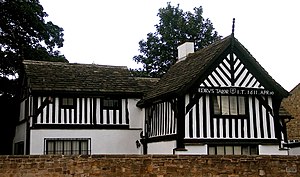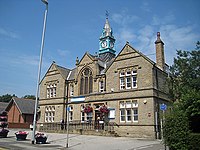Loading map...
{"minzoom":false,"maxzoom":false,"mappingservice":"leaflet","width":"auto","height":"350px","centre":false,"title":"","label":"","icon":"","lines":[],"polygons":[],"circles":[],"rectangles":[],"copycoords":false,"static":false,"zoom":13,"defzoom":14,"layers":["OpenStreetMap"],"image layers":[],"overlays":[],"resizable":false,"fullscreen":true,"scrollwheelzoom":false,"cluster":false,"clustermaxzoom":20,"clusterzoomonclick":true,"clustermaxradius":80,"clusterspiderfy":true,"geojson":"","clicktarget":"","imageLayers":[],"locations":[{"text":"\u003Cb\u003E\u003Cdiv class=\"mw-content-ltr mw-parser-output\" lang=\"en\" dir=\"ltr\"\u003E\u003Cp\u003E\u003Ca href=\"/wiki/Carlton_Hall_Farmhouse\" title=\"Carlton Hall Farmhouse\"\u003ECarlton Hall Farmhouse\u003C/a\u003E\n\u003C/p\u003E\u003C/div\u003E\u003C/b\u003E\u003Cdiv class=\"mw-content-ltr mw-parser-output\" lang=\"en\" dir=\"ltr\"\u003E\u003Cp\u003E\u003Ca href=\"/wiki/Carlton_Hall_Farmhouse\" title=\"Carlton Hall Farmhouse\"\u003E\u003Cb\u003ECarlton Hall Farmhouse\u003C/b\u003E is a 16th century home and Grade II listed building in the village of Carlton. The home was formerly the manor house for the lords of Carlton and has had extensive alterations, particularly in the 18th century.\u003C/a\u003E\n\u003C/p\u003E\u003C/div\u003E","title":"Carlton Hall Farmhouse\n","link":"","lat":53.73965,"lon":-1.49362,"icon":"//static.miraheze.org/rothwellwiki/f/f6/Tudor_Icon.svg"},{"text":"\u003Cb\u003E\u003Cdiv class=\"mw-content-ltr mw-parser-output\" lang=\"en\" dir=\"ltr\"\u003E\u003Cp\u003E\u003Ca href=\"/wiki/NE_Region_Emergency_Grid_Control_Centre\" title=\"NE Region Emergency Grid Control Centre\"\u003ENE Region Emergency Grid Control Centre\u003C/a\u003E\n\u003C/p\u003E\u003C/div\u003E\u003C/b\u003E\u003Cdiv class=\"mw-content-ltr mw-parser-output\" lang=\"en\" dir=\"ltr\"\u003E\u003Cp\u003E\u003Ca href=\"/wiki/NE_Region_Emergency_Grid_Control_Centre\" title=\"NE Region Emergency Grid Control Centre\"\u003EThe \u003Cb\u003ENorth-East Region Emergency Grid Control Centre\u003C/b\u003E was a concrete bunker that housed emergency controls for the North-East region's electricity grid. It was built in 1953, presumably by the British Electricity Authority (BEA), as one of eight such emergency controls in similarly remote areas to provide alternative controls for the electrical grid in case of attack or disruption to the main control centres.\u003C/a\u003E\n\u003C/p\u003E\u003C/div\u003E","title":"NE Region Emergency Grid Control Centre\n","link":"","lat":53.74377,"lon":-1.50982,"icon":"//static.miraheze.org/rothwellwiki/c/c2/20th_Icon.svg"},{"text":"\u003Cb\u003E\u003Cdiv class=\"mw-content-ltr mw-parser-output\" lang=\"en\" dir=\"ltr\"\u003E\u003Cp\u003E\u003Ca href=\"/wiki/Pyemont_House\" title=\"Pyemont House\"\u003EPyemont House\u003C/a\u003E\n\u003C/p\u003E\u003C/div\u003E\u003C/b\u003E\u003Cdiv class=\"mw-content-ltr mw-parser-output\" lang=\"en\" dir=\"ltr\"\u003E\u003Cp\u003E\u003Ca href=\"/wiki/Pyemont_House\" title=\"Pyemont House\"\u003E\u003Cb\u003EPyemont House\u003C/b\u003E (also spelt as 'Pymont House' and known as 'Pyemont House and Cottage') is a listed farmhouse in Lofthouse. While the brickwork suggests the house was built in the 17th century, the timber-framing suggests that part of the building is from the 16th century. The house is named after the Pyemont family, who inherited the house in the late 17th century.\u003C/a\u003E\n\u003C/p\u003E\u003C/div\u003E","title":"Pyemont House\n","link":"","lat":53.7305,"lon":-1.49683,"icon":"//static.miraheze.org/rothwellwiki/f/f6/Tudor_Icon.svg"},{"text":"\u003Cb\u003E\u003Cdiv class=\"mw-content-ltr mw-parser-output\" lang=\"en\" dir=\"ltr\"\u003E\u003Cp\u003E\u003Ca href=\"/wiki/Rothwell_Castle\" title=\"Rothwell Castle\"\u003ERothwell Castle\u003C/a\u003E\n\u003C/p\u003E\u003C/div\u003E\u003C/b\u003E\u003Cdiv class=\"mw-content-ltr mw-parser-output\" lang=\"en\" dir=\"ltr\"\u003E\u003Cp\u003E\u003Ca href=\"/wiki/Rothwell_Castle\" title=\"Rothwell Castle\"\u003E\u003Cb\u003ERothwell Castle\u003C/b\u003E was a timber castle or fortified manor house, which was built by Ilbert de Lacy in the 11th century. The manor, given its close proximity to [https://en.wikipedia.org/wiki/Pontefract_Castle Pontefract Castle], would have only been a satellite but would have been important as an administrative centre. The remains of the site are now a scheduled monument.\u003C/a\u003E\n\u003C/p\u003E\u003C/div\u003E","title":"Rothwell Castle\n","link":"","lat":53.75002,"lon":-1.48205,"icon":"//static.miraheze.org/rothwellwiki/a/a2/Medieval_Icon.svg"},{"text":"\u003Cb\u003E\u003Cdiv class=\"mw-content-ltr mw-parser-output\" lang=\"en\" dir=\"ltr\"\u003E\u003Cp\u003E\u003Ca href=\"/wiki/Rothwell_Empire_Cinema\" title=\"Rothwell Empire Cinema\"\u003ERothwell Empire Cinema\u003C/a\u003E\n\u003C/p\u003E\u003C/div\u003E\u003C/b\u003E\u003Cdiv class=\"mw-content-ltr mw-parser-output\" lang=\"en\" dir=\"ltr\"\u003E\u003Cp\u003E\u003Ca href=\"/wiki/Rothwell_Empire_Cinema\" title=\"Rothwell Empire Cinema\"\u003EThe \u003Cb\u003ERothwell Empire Cinema\u003C/b\u003E was a cinema that opened on 8th May 1913. The cinema closed between 1933 and 1935.\u003C/a\u003E\n\u003C/p\u003E\u003C/div\u003E","title":"Rothwell Empire Cinema\n","link":"","lat":53.7489,"lon":-1.47602,"icon":"//static.miraheze.org/rothwellwiki/c/c2/20th_Icon.svg"},{"text":"\u003Cb\u003E\u003Cdiv class=\"mw-content-ltr mw-parser-output\" lang=\"en\" dir=\"ltr\"\u003E\u003Cp\u003E\u003Ca href=\"/wiki/Rothwell_One_Stop_Area_Office\" title=\"Rothwell One Stop Area Office\"\u003ERothwell One Stop Area Office\u003C/a\u003E\n\u003C/p\u003E\u003C/div\u003E\u003C/b\u003E\u003Cdiv class=\"mw-content-ltr mw-parser-output\" lang=\"en\" dir=\"ltr\"\u003E\u003Cp\u003E\u003Ca href=\"/wiki/Rothwell_One_Stop_Area_Office\" title=\"Rothwell One Stop Area Office\"\u003EThe \u003Cb\u003ERothwell One Stop Area Office\u003C/b\u003E, formerly known as the \u2018\u003Cb\u003ERothwell Urban District Offices\u003C/b\u003E\u2019 and more commonly as the \u2018\u003Cb\u003ERothwell Civic Building\u003C/b\u003E\u2019, is the historical administrative headquarters of the Rothwell Urban District Council and later was used as offices for Leeds City Council.\u003C/a\u003E\n\u003C/p\u003E\u003C/div\u003E","title":"Rothwell One Stop Area Office\n","link":"","lat":53.74731,"lon":-1.47846,"icon":"//static.miraheze.org/rothwellwiki/7/72/19th_Icon.svg"},{"text":"\u003Cb\u003E\u003Cdiv class=\"mw-content-ltr mw-parser-output\" lang=\"en\" dir=\"ltr\"\u003E\u003Cp\u003E\u003Ca href=\"/wiki/The_Nookin\" title=\"The Nookin\"\u003EThe Nookin\u003C/a\u003E\n\u003C/p\u003E\u003C/div\u003E\u003C/b\u003E\u003Cdiv class=\"mw-content-ltr mw-parser-output\" lang=\"en\" dir=\"ltr\"\u003E\u003Cp\u003E\u003Ca href=\"/wiki/The_Nookin\" title=\"The Nookin\"\u003E\u003Cb\u003EThe Nookin\u003C/b\u003E is a Grade II* listed building in Oulton that dates to the 16th Century, which architectural historian Nikolaus Pevsner called the best piece of timber architecture in the district. While the date on the front beam is the 10th April 1611, this is likely the date of its renovation by Edward Tailor, and carbon dating has shown that this beam is upwards of 1000 years old.\u003C/a\u003E\n\u003C/p\u003E\u003C/div\u003E","title":"The Nookin\n","link":"","lat":53.75008,"lon":-1.45667,"icon":"//static.miraheze.org/rothwellwiki/f/f6/Tudor_Icon.svg"},{"text":"\u003Cb\u003E\u003Cdiv class=\"mw-content-ltr mw-parser-output\" lang=\"en\" dir=\"ltr\"\u003E\u003Cp\u003E\u003Ca href=\"/wiki/Thorpe_Hall\" title=\"Thorpe Hall\"\u003EThorpe Hall\u003C/a\u003E\n\u003C/p\u003E\u003C/div\u003E\u003C/b\u003E\u003Cdiv class=\"mw-content-ltr mw-parser-output\" lang=\"en\" dir=\"ltr\"\u003E\u003Cp\u003E\u003Ca href=\"/wiki/Thorpe_Hall\" title=\"Thorpe Hall\"\u003E\u003Cb\u003EThorpe Hall\u003C/b\u003E (also spelt as 'Thorp Hall' and referred to as 'Thorpe Hall Farm') is a listed 18th century building that was the seat of Thorpe-on-the-Hill's local gentry, notably the Gascoigne and Proctor families. While the rainwater heads date the building at 1735, the hall incorporated a late-medieval timber framed wing. Once boasting \"exceptionally fine decoration\", it now stands derelict.\u003C/a\u003E\n\u003C/p\u003E\u003C/div\u003E","title":"Thorpe Hall\n","link":"","lat":53.73852,"lon":-1.52235,"icon":"//static.miraheze.org/rothwellwiki/a/a1/18th_Icon.svg"},{"text":"\u003Cb\u003E\u003Cdiv class=\"mw-content-ltr mw-parser-output\" lang=\"en\" dir=\"ltr\"\u003E\u003Cp\u003E\u003Ca href=\"/wiki/Church_of_All_Saints\" title=\"Church of All Saints\"\u003EChurch of All Saints\u003C/a\u003E\n\u003C/p\u003E\u003C/div\u003E\u003C/b\u003E\u003Cdiv class=\"mw-content-ltr mw-parser-output\" lang=\"en\" dir=\"ltr\"\u003E\u003Cp\u003E\u003Ca href=\"/wiki/Church_of_All_Saints\" title=\"Church of All Saints\"\u003EThe \u003Cb\u003EChurch of All Saints\u003C/b\u003E (also known as \"All Saints Church\" and now \"All Saints House\") was an Anglican church that opened in 1870 and closed in 1995. It is a Grade II listed building that is now a private home.\u003C/a\u003E\n\u003C/p\u003E\u003C/div\u003E","title":"Church of All Saints\n","link":"","lat":53.75808,"lon":-1.44646,"icon":"//static.miraheze.org/rothwellwiki/7/72/19th_Icon.svg"},{"text":"\u003Cb\u003E\u003Cdiv class=\"mw-content-ltr mw-parser-output\" lang=\"en\" dir=\"ltr\"\u003E\u003Cp\u003E\u003Ca href=\"/wiki/Church_of_St_Andrew\" title=\"Church of St Andrew\"\u003EChurch of St Andrew\u003C/a\u003E\n\u003C/p\u003E\u003C/div\u003E\u003C/b\u003E\u003Cdiv class=\"mw-content-ltr mw-parser-output\" lang=\"en\" dir=\"ltr\"\u003E\u003Cp\u003E\u003Ca href=\"/wiki/Church_of_St_Andrew\" title=\"Church of St Andrew\"\u003EThe \u003Cb\u003EChurch of St Andrew\u003C/b\u003E was an Anglican church on Pontefract Road in Stourton. The church replaced a small iron mission and was consecrated on 23rd July 1898. St Andrew's closed around 1973 when the residents of Stourton were displaced to turn it into an industrial area.\u003C/a\u003E\n\u003C/p\u003E\u003C/div\u003E","title":"Church of St Andrew\n","link":"","lat":53.774423,"lon":-1.513709,"icon":"//static.miraheze.org/rothwellwiki/7/72/19th_Icon.svg"},{"text":"\u003Cb\u003E\u003Cdiv class=\"mw-content-ltr mw-parser-output\" lang=\"en\" dir=\"ltr\"\u003E\u003Cp\u003E\u003Ca href=\"/wiki/Possible_Roman_Settlement_(Rothwell_Haigh)\" class=\"mw-redirect\" title=\"Possible Roman Settlement (Rothwell Haigh)\"\u003ERoman Settlement\u003C/a\u003E\n\u003C/p\u003E\u003C/div\u003E\u003C/b\u003E\u003Cdiv class=\"mw-content-ltr mw-parser-output\" lang=\"en\" dir=\"ltr\"\u003E\u003Cp\u003E\u003Ca href=\"/wiki/Possible_Roman_Settlement_(Rothwell_Haigh)\" class=\"mw-redirect\" title=\"Possible Roman Settlement (Rothwell Haigh)\"\u003EA possible Roman settlement was uncovered in Rothwell Haigh when, in 1977, the West Yorkshire County Archaeology Unit excavated a site at what was then Rothwell Colliery, and what is now Rothwell Country Park. While there was little evidence of the settlement itself, there was evidence of human activity on the site from the late 2nd to the early 3rd century.\u003C/a\u003E\n\u003C/p\u003E\u003C/div\u003E","title":"Roman Settlement\n","link":"","lat":53.762778,"lon":-1.466667,"icon":"//static.miraheze.org/rothwellwiki/f/f0/Roman_Icon.svg"},{"text":"\u003Cb\u003E\u003Cdiv class=\"mw-content-ltr mw-parser-output\" lang=\"en\" dir=\"ltr\"\u003E\u003Cp\u003E\u003Ca href=\"/wiki/Rothwell_Country_Park\" title=\"Rothwell Country Park\"\u003ERothwell Country Park\u003C/a\u003E\n\u003C/p\u003E\u003C/div\u003E\u003C/b\u003E\u003Cdiv class=\"mw-content-ltr mw-parser-output\" lang=\"en\" dir=\"ltr\"\u003E\u003Cp\u003E\u003Ca href=\"/wiki/Rothwell_Country_Park\" title=\"Rothwell Country Park\"\u003ERothwell Country Park is a 52 hectares public park, between the north of Rothwell and the Aire and Calder Navigation. The park is a Local Wildlife Site, with a pond trail and a sculpture trail a summit, which offers a view of Leeds and connections to the Trans-Pennine Way.\u003C/a\u003E\n\u003C/p\u003E\u003C/div\u003E","title":"Rothwell Country Park\n","link":"","lat":53.76152,"lon":-1.46321,"icon":"//static.miraheze.org/rothwellwiki/a/aa/21st_Icon.svg"}],"imageoverlays":null}




















